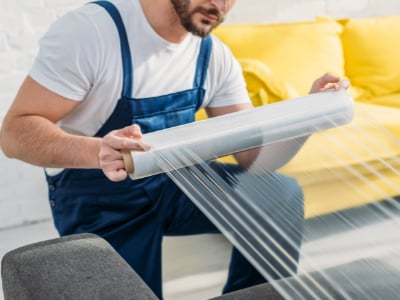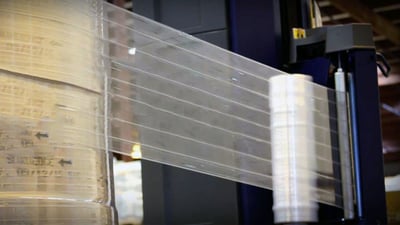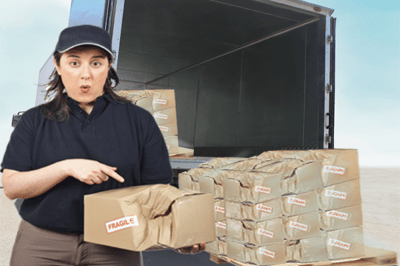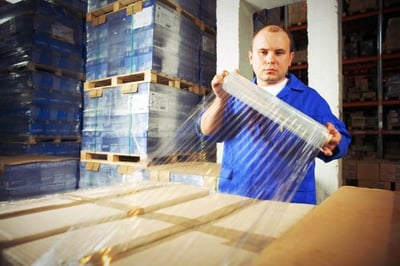Why Hand-Wrapping Pallets is Losing You Money
Equipment | Packaging Materials | Environment | The Business of Packaging | Technical Service and Support | Plant Performance | Investment | Shipping Protection
Are you stretch wrapping your pallets by hand? Relying on manual labor to consistently protect your products in transit may be causing your company to lose money in the long run.
Suppose your products are in high demand and you are cutting it close or, even worse, missing your customer's requested orders. In that case, you may be able to remedy this with automation at your end-of-line.
Hand-wrapping pallets are less cost-effective than using a stretch wrapper at a certain point. At the same time, automated stretch-wrapping machinery can save on time and costs.
Does the idea of saving money have your attention? Learn how to determine when to switch from hand-wrapping pallets to automated pallet-wrapping machinery.
Hand-Wrapping Pallets Equals Lower Productivity And Higher Cost
Manual wrapping in your production line is not efficient for higher volume manufacturers. While the rest of your line may be pumping out finished goods ready to be palletized, the workers at the end of the production line are literally running around in circles to meet targets.
Significant productivity increases can be seen with the automation of your end-of-line packaging solutions. Even with a minor upgrade to a semi-automatic pallet wrapper, it is possible to see increases of 100% or more.
A customer evaluated their productivity around palletizing and found that their employees spent an average of four minutes wrapping a single pallet by hand. Talk about getting the spins at work! Two of their employees were wrapping 125 pallets each per week.
By upgrading to a semi-automatic pallet wrapper, they cut the time spent wrapping a pallet in half to 2 minutes, ultimately cutting over 8 hours per week in labor costs and getting their products out the door much faster.

Hand-Wrapping Pallets Means Less Protection
It's been proven that hand wrapping doesn't protect as much as wrapping machinery due to how tightly and consistently automated pallet wrapping machinery can secure and safeguard products compared to a person.
Human error is bound to affect balanced loads. The human body cannot consistently apply an even stretch force and provide proper load containment all the time, thanks to fatigue and the slew of other hindrances that consciousness gives us.
This opportunity for human error often leads to double checks on proper pallet containment before loading each pallet into trucks for shipment. Making sure that everything is wrapped securely over and over by your labor force will certainly cause lower productivity for your plant floor.
The protection of your employees is also lessened with manual wrapping. The potential for work-related injuries for dizzy employees is a much higher risk, leading to higher insurance rates.
A study by OSHA regarding manually wrapping pallets found that the awkward body positions that hand wrapping pallets requires puts your employees at risk for musculoskeletal disorders (MSDs).
While you are not spending significantly on automation, you are spending more than you could be on stretch wrap and labor force.
An automated machine will provide consistent wrapping capabilities, less film usage, and a lower potential for a work-related injury on your plant floors.
How much money can you save with an automated stretch wrapper?

Hand-Wrapping Pallets Leads To Missed Potential
Another benefit to upgrading and automating is much more wrap potential with automated pallet wrapping machinery.
You can significantly reduce the amount of film waste (which is excellent for your business's environmental footprint) while maintaining safe load containment.
This is because automated wrappers can maximize the amount of stretch that is achieved much more than we can by hand. You can expect your employees to average 25%-40% stretch when wrapping a pallet by hand.
Compare this with an average of 250% or more that an automated or semi-automated pallet wrapper can achieve. This type of automation can save quite a bit in film usage with its ability to pre-stretch each roll of stretch film.
The average you can expect to save on film costs with the upgrade to automated wrapping is 25-40%, thanks to the more reliable load containment and higher pre-stretch.
In optimal cases, you will see an average of 66% in film savings! This can be enough to help you in justifying the capital investment in automation.

Hand-Wrapping Pallets Often Leads To Load Damage
If not appropriately wrapped by hand, your pallets could shift during transport, ultimately destroying and adding to the overall costs of producing your product.
The real costs of shipping damage due to improperly secured loads are not always fully realized because many of the actual costs are not calculated into the final number.
Consider each damaged load you are faced with and the cost of each damaged good, labor from the start of production for that product until the damage occurred, energy, and include the cost of the pallets, film, and wrapping costs.
Don't forget to consider the cost of the original shipping, re-shipping the damaged products back, and shipping its replacement out again.
The cost of picking and packing the products should also be factored in when calculating your spending on load damage. This is why supplemental shipping insurance should be a consideration for your business, if not a necessity.
Automating your pallet wrapping can significantly reduce the load damage you face, thanks to its consistency and reliability in securing loads.
Did you know that specific load containment and wrap forces are required to achieve a secure load for every type of palletized shipment?
If you don't know these for your pallets, there are tools available that we can help you with to help you determine them.
Containment force is more important than the number of times a pallet is wrapped or the gauge of the stretch film used.
According to an interview with Jim Lancaster, CEO of Lantech (the claimed inventor of stretch wrap and the first automated pallet wrapper), wrapping the top and the bottom of a pallet with more stretch wrap is an old wives tale.
To assure a secure shipment, you must apply the minimum containment force for your loaded pallet everywhere on the load.
If this is true, consistently relying on manual labor to achieve the proper load containment to reduce or eliminate load damage seems impractical.
Determining When To Stop Hand-Wrapping Pallets And Using A Stretch Wrapper
After reviewing the above, it may already seem like a no-brainer for your production lines to automate your very end-of-line. If not, here are some questions to help you determine when you will be ready:
- What are your needs for output (demand) per week/month/quarter/year?
- Consider the amount of pallets you're wrapping on a weekly basis. If you have over 50 pallets going out per week, you could potentially see a return on investment in a year, give-or-take.
- How much are you spending on stretch films on a monthly or quarterly basis?
- With the knowledge that you can achieve an average of 250% or more pre-stretch on your films with an automated wrapper, see how much you could save on film costs alone by upgrading.
- How much are you spending in damaged goods each quarter/year?
- How much of this load damage can you directly correlate to your load containment or shifting pallet loads? Understand what irregular load wraps are really costing your business.
- How long does each pallet take to be wrapped from loading to placement in the carrier trucks?
- Add how much your employees are paid into this equation and consider this a cost of your damaged goods. Don't forget to add in any wrapping-related injury costs. Does the manual wrapping slow down your production as a whole?
Considering all of these factors, how much does manual wrapping actually cost you? How long would it take you to see ROI if you could automate it?
If you want to learn more about your options for automation, talk to one of our Packaging Pros about your operation.
About David Roberge
I am grateful to be part of the outstanding Industrial Packaging team. I am able to hang out with some of the most knowledgeable folks in the packaging industry. I feel even luckier that I am able to share that knowledge with you. I love learning, hiking, and growing people and teams both personally and professionally, and helping companies grow better.





